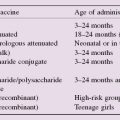Satisfactory immunity depends on the interaction of such an enormous variety of cells and molecules that inevitably a corresponding variety of different defects can reduce its efficiency, all with much the same end result: increased susceptibility to infection (right). There is a tendency for somewhat different patterns of disease according to whether the defect predominantly affects T cells (top), antibody and/or complement (centre) or myeloid cells (bottom).
Immunodeficiency may be secondary to other conditions (e.g. drugs, malnutrition or infection itself) or, less commonly, a result of primary genetic defects. It is remarkable how many of the latter are ‘X-linked’ (i.e. inherited by boys from their mothers; top left ⊗ in figure), suggesting that the unpaired part of the X chromosome carries several immunologically important genes (see Fig. 47). In some cases it appears that cell differentiation is interrupted at a particular stage (black arrows), but much more often there is a variable mixture of partial and apparently disconnected defects. The remarkable advances in genetics, and especially the ability to sequence enormous amounts of DNA, have resulted in a rapid increase in the number of diseases for which the missing gene product has now been identified (e.g. individual complement components, polymorph or lymphocyte enzymes (black circles), or cytokine receptor and adhesion molecules). Treatments being developed focus on replacement therapy, using either genes (gene therapy) or proteins. Although generally rare, these diseases have taught immunologists an enormous amount about the human immune system, providing ‘experiments of nature’ which complement and expand the many experimental genetic models developed in animals, especially rodents (for further details see Fig. 47).
The incidence of primary immunodeficiency depends on the definition of normality. Some scientists would argue that any manifestation of disease caused by infection reflects some level of immunodeficiency. Certainly both the frequency with which ‘normal’ people succumb to colds, sore throats and food poisoning etc. and the severity of the ensuing illnesses varies enormously between individuals. However, serious deficiency is found only in about one person per 1000.
Defects Affecting Several Types of Cell
Ret. Dys.
Reticular dysgenesis, a complete failure of stem cells, not compatible with survival for more than a few days after birth.
SCID
Severe combined immunodeficiency, in which both T and B cells are defective. Some cases appear to be caused by deficiency of an enzyme, adenosine deaminase (ADA), which can be replaced by blood or marrow transfusion. Others result from a mutation in a cytokine receptor (the shared γ chain of the IL-2, IL-4 and IL-7 receptor). Recent gene therapy trials have used recombinant retroviruses to introduce the missing gene into bone marrow stem cells and have resulted in reconstitution of fully functional immune system. In a small number of children, however, tumours apparently caused by retroviral insertion have been reported. In some cases, HLA class I or II molecules are absent from lymphocytes (‘bare lymphocyte syndrome’).
Atax. Tel.
Stay updated, free articles. Join our Telegram channel

Full access? Get Clinical Tree




